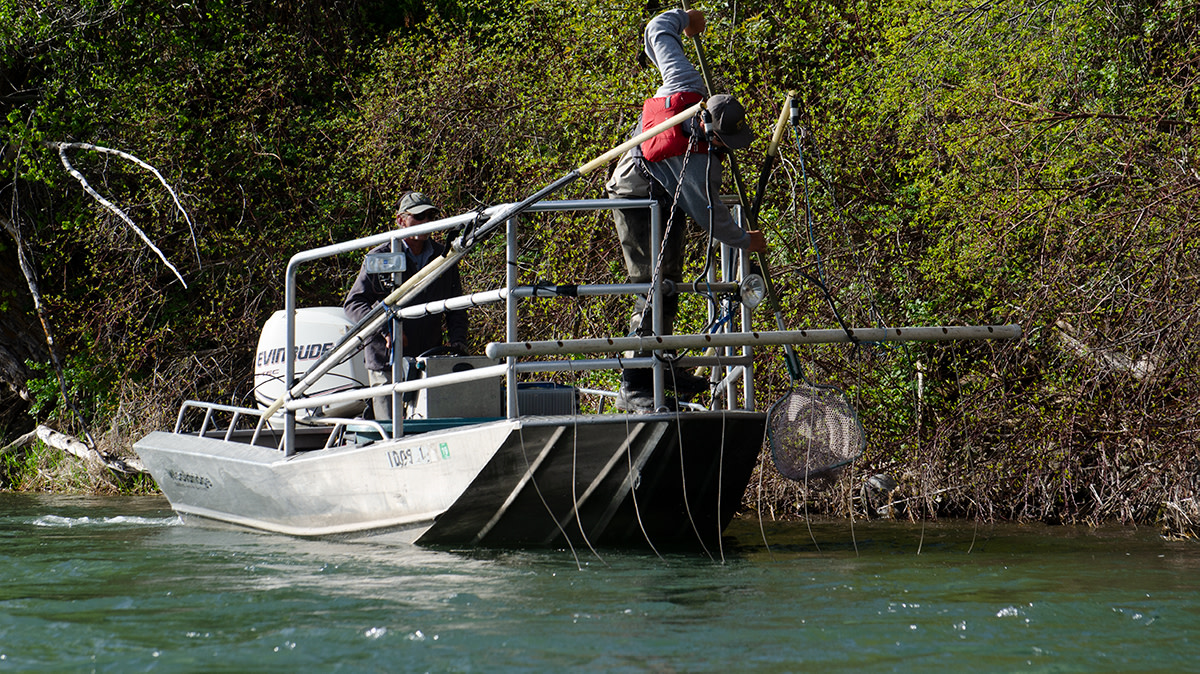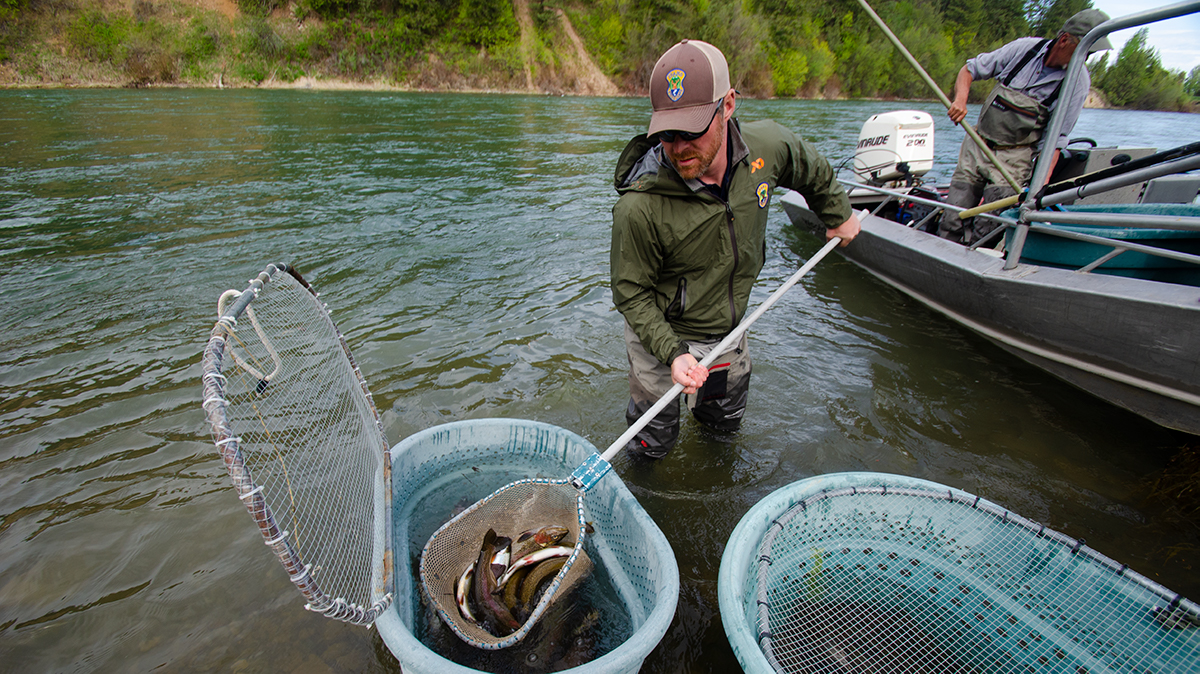
Fisheries technician Glenn Mabey, 21, leans hard against the railing on the jetboat’s bow. His hands grip a 12-foot-long net; his eyes scan the heavy water below. Mabey flinches as fish flash gold and yellow toward the giant anode suspended off the bow, but he holds steady. A flash of red and green erupts underwater, and he stabs like a heron, scooping a trout, swinging the net alongside the boat, up and over the gunwale, and then deftly inverting the basket to deposit the fish in a huge bucket with flick of his wrist. Seconds later he repeats the process with two more rainbow trout plucked out of the South Fork of the Snake River.
Mabey, our talented jetboat pilot Chuck Traughber, and their colleagues in a second electro-rigged jetboat removed several thousand rainbow trout from the stream. For the past 15 years, the Idaho Department of Fish & Game have been testing ways to control the spread of invasive rainbows in the South Fork. Removing rainbows, they hope, will bolster the trout species native to that drainage—Yellowstone cutthroat. The local angling community, however, is sharply divided over the wisdom of this project. Fishermen generally recoil at seeing desirous, catchable fish removed from their favorite waters.
Cutthroat trout are the indigenous salmonid of the Rocky Mountain West and are roughly divided into 14 subspecies. The Yellowstone strain, Oncorhynchus clarkii bouvieri, is distinguished by large spots concentrated near the tail. They carry the classic cutthroat yellow, with orange and red accents near spring spawning time, and those distinctive throat slashes. These cutthroat are only found in the Greater Yellowstone Ecosystem, and this population is one of the only west of the continental divide.
Rainbow trout are one of the most popular sportfish in America. Though native to only five countries and seven states, they now exist in all 50 states and more than 100 countries worldwide due to intensive stocking efforts—some introductions dating back more than 150 years. Rainbows are native to Idaho but not to the South Fork of the Snake, and their populations in the stream have increased since the mid-1990s. Current estimates suggest there are more than 90,000 rainbows between Palisades Dam and the confluence with the Henry’s Fork.
Patrick Kennedy, IDFG regional fisheries biologist, leads the effort to suppress rainbow trout populations in the South Fork.
“The goal is not to eliminate rainbows but to give cutthroat a bump,” Kennedy said. “We want to see cutthroat trends coming up. The rainbow population is currently at the highest on record, and it’s doubled since 2002. Hybridization is the concern.”
Cutthroat are native to the Rockies, while rainbows are the native to the Pacific Coast. The species are so closely related that they can interbreed and produce viable, fertile offspring—a rarity with interspecies hybrids. Idaho is concerned that such hybridization could dilute the native cutthroat gene pool to the point where the species is effectively eliminated. That would almost certainly lead to a listing under the Endangered Species Act and the attendant onerous federal regulations that Idaho, and its anglers, would like to avoid. Fish advocates have already petitioned the EPA to list Yellowstone cutthroat once before.
“The sticker here is that it’s a large river with native cutthroat. It’s the only one other than the Upper Yellowstone with an intact population and multiple life histories,” Kennedy said. “Most places try to isolate them, which can lead to inbreeding depression. It’s nice that we’ve maintained tributary spawners, mainstem spawners and tributary residents.”
IDFG has operated weirs on many of the tributaries of the South Fork Snake since the mid-1990s. These weirs trap rainbows and prevent them from reaching cutthroat spawning grounds. In 2004, Idaho changed the fishing regulations on the South Fork, putting a zero limit on cutthroat and an unlimited daily limit on rainbow trout. In 2009, they went so far as to create a harvest incentive program. Hundreds of rainbows are tagged with coded wires that anglers can turn in for monetary prizes from $50 to $1,000. There’s only one catch, the wires have to be submitted while still attached to decapitated trout heads to prove the fish were actually removed.
Despite all these efforts, the rainbow population continued to surge. So, in 2019 IDFG took the more drastic step of electro-fishing removal. They chose May in order to target rainbows on their spawning redds with the goal of removing 5,000 to 10,000 fish, mostly to find out how well such a project would work.
To accomplish this, they rigged two large jetboats with long superstructures off the bows suspending electrical anodes in the water. The anodes produce a low-voltage electric current that makes a circuit with the aluminum boat hull, putting any fish within reach into a paralytic state called taxis. The fish are not electrocuted; rather, the specific DC frequency contracts fishes’ muscles in such a way that causes them to swim like zombies toward the anode. The associated mortality is very low, although some local bald eagles have learned capitalize on the incapacitated fish.
In our day on the water, the crew netted 405 rainbow trout in three hours, which they transferred to in-stream live wells, then to a tank truck. Glenn Mabey then drove the tank truck to a kid’s-only fishing pond outside Victor, Idaho. Several rainbows and cutt-bow hybrids over 20 inches are now circling that pond where, hopefully, they’ll bring a huge grin to a young angler with a snoopy pole.
“I take my kids to that pond all the time,” said Brad Higginson, a Forest Service hydrologist who helped with the netting. “I took my dad out too and he was like ‘get out of my way!’”
But not all anglers are so enthused about IDFG’s project on the South Fork.
“We have to recognize and acknowledge that anglers like rainbows,” Kennedy said. “We don’t want to get rid of them because that’s not feasible. We’d just love to see cutthroat [populations] higher than bows.”
One fishing guide we spoke to sneeringly called the project “shock and awe.” The international outfitting and guide school operation World Cast in Victor publicly opposes it.
Ed Emory lives in the Swan Valley a few minutes away from the South Fork and has been guiding the river for years. He said the cutthroat in the tailwater reach of the South Fork are not true natives because millions of hatchery reared cutthroat have been planted in Palisades Reservoir above the dam over several decades and many of those fish have likely washed downstream and polluted the river’s gene pool.
“Over 300,000 people float the South Fork annually and less than .5% have chosen to participate in the IDFG rainbow removal incentive program. The public has voted by choosing not to participate,” Emory said. “The South Fork is place where anglers can catch browns, rainbows and, of course, cutthroats. We need to celebrate the most diverse fishery in the world instead of vilifying a species that has become naturalized. Any continued efforts to remove the rainbows will interfere with the robust economies and livelihoods the river supports.”
Many other local guides echo Emory’s sentiments, saying they rely on the numerous rainbows to put clients on fish. But to some it is worth having fewer of the ubiquitous rainbows to promote a rare, endemic, beautiful and large species of native fish.
“Nobody comes to the south fork to catch a rainbow, they go to the Henry’s Fork,” said Rob Parkins, a longtime guide, resident of Victor and water policy coordinator for Backcountry Hunters & Anglers. “The cutthroat is a great dry-fly eating fish. It’s a shame to see a diminishing population of these beautiful, native fish in the South Fork.”
It’s hard to get anglers to agree on anything, not the best presentation, not the right time of day to fish. Sometimes, it seems they’ll even argue over the color of the sky. The removal of thousands of a popular sportfish from a river is certain to generate controversy, but hopefully a restored Snake River Yellowstone cutthroat trout population will eventually be something everyone can take pride in.







Conversation